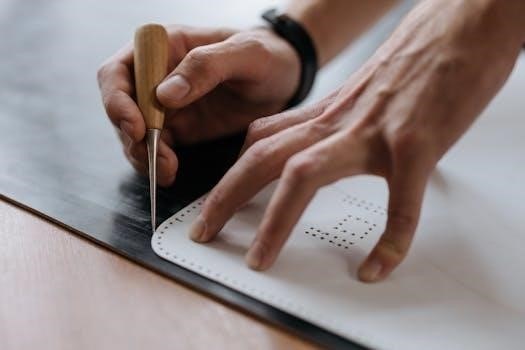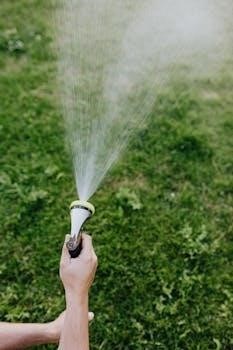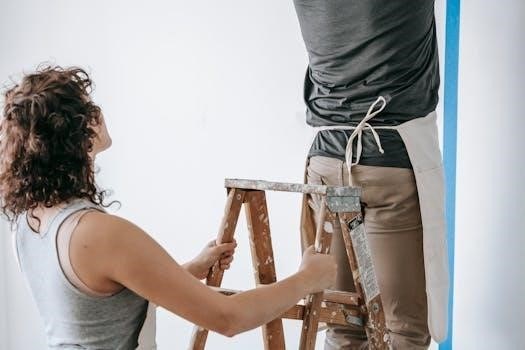
diy hose guide
DIY hose guides offer a practical and cost-effective solution for managing garden hoses. These guides protect plants by preventing hose drag and crushing. They also enhance safety by reducing tripping hazards and can add a touch of personalization to your garden.
Why Use Hose Guides?
Hose guides serve a vital purpose in any garden or landscape where water hoses are used regularly. Primarily, they prevent damage to delicate plants and flowers. Dragging a hose through a garden can easily crush stems, break leaves, and disrupt root systems. Hose guides act as barriers, directing the hose away from sensitive areas and keeping it on a designated path. They also reduce the risk of tripping, especially when hoses are left haphazardly across walkways or lawns. Additionally, using hose guides helps to maintain a neater and more organized garden space, reducing clutter and improving overall aesthetics. Furthermore, hose guides contribute to the longevity of your hose by minimizing abrasion against rough surfaces. These tools are not just a convenience but a necessity for efficient and careful gardening.
Benefits of DIY Hose Guides
Creating your own hose guides offers numerous advantages beyond the basic functionality. DIY projects are inherently cost-effective, utilizing readily available or upcycled materials, saving money compared to store-bought options. They allow for complete customization, matching your garden’s aesthetic and specific needs. You can choose materials, colors, and designs that blend with your landscape or add a unique decorative touch. DIY guides are a sustainable choice, reducing waste by repurposing items like wine bottles or doorknobs. These projects are also incredibly rewarding, providing a sense of accomplishment and creativity. Furthermore, they encourage resourcefulness and a hands-on approach to gardening, making the process more engaging. Lastly, DIY guides are easily adaptable, allowing you to modify them as your garden evolves, providing a long-term solution.

Materials for DIY Hose Guides
Common materials include rebar, PVC or copper pipe, wine bottles, doorknobs, grower pots, nails, and even golf balls. These can be combined in various ways for effective hose management.
Rebar and Protective Sleeves
Rebar, a sturdy steel rod, serves as an excellent base for DIY hose guides due to its strength and ability to be anchored into the ground. To protect the hose and add functionality, a protective sleeve is often added over the rebar. This sleeve can be made from various materials, such as PVC or copper piping, chosen for their smooth surfaces that allow the hose to glide easily. The sleeve also prevents direct contact between the hose and the rebar, which could cause abrasion or damage. The length of the sleeve should be slightly longer than the exposed rebar, ensuring full coverage. This combination of rebar and a protective sleeve creates a simple, durable, and effective hose guide. You can make them more attractive by adding decorative elements to the pipe.
Upcycled Materials
Upcycling offers a creative and environmentally friendly approach to crafting DIY hose guides. Instead of purchasing new materials, you can repurpose items you already have. Old wine bottles, for example, can be inverted over rebar to create a decorative and functional guide. Similarly, discarded doorknobs can be mounted onto sturdy bases to serve as unique hose guides. Even grower pots, often found in garden centers, can be used with large nails to create simple, yet effective guides. Using upcycled materials not only reduces waste but also allows for personalized and budget-friendly garden solutions. This approach adds character and charm to your garden while promoting sustainability and resourcefulness. This way, you can give a second life to everyday objects.

DIY Hose Guide Construction Techniques
Various methods exist for constructing DIY hose guides. These include using rebar with PVC pipe, repurposing wine bottles, or mounting doorknobs, each offering unique aesthetics and functionality for your garden.
Rebar and PVC Pipe Method
The rebar and PVC pipe method is a popular and straightforward approach for creating durable DIY hose guides. This technique involves inserting a length of rebar into the ground to serve as a sturdy anchor. A piece of PVC or copper pipe, slightly longer than the exposed rebar, is then slipped over it. This pipe acts as a sleeve, allowing the garden hose to glide smoothly as it is pulled around the garden. The pipe rotates, preventing the hose from snagging or getting caught. This method is not only functional but also allows for creative enhancements. You can add a decorative element on top of the pipe to make it more visually appealing. The rebar provides stability, while the PVC pipe protects the hose from abrasion, making it an ideal combination for long-lasting hose guides.
Using Wine Bottles
Repurposing wine bottles into hose guides is a creative and visually appealing DIY project. This method involves anchoring a section of rebar into the ground, similar to other techniques. Then, an empty wine bottle is inverted and carefully placed over the rebar. The neck of the bottle rests on the ground, while the base points upwards. This creates a smooth, rounded surface for the hose to glide around, preventing it from damaging plants. The colorful glass of the wine bottles adds a decorative touch to the garden, turning a functional item into a piece of garden art. This approach is not only eco-friendly but also adds a unique and personal touch to your garden. You can use different colored bottles to create a vibrant and eye-catching display throughout your garden.
Doorknob Hose Guides
Utilizing old or decorative doorknobs for hose guides presents another unique and charming DIY option. This method involves mounting doorknobs onto a sturdy base, such as a piece of wood or a metal stake, that can be securely positioned in the ground. The rounded shape of the doorknob provides a smooth surface for the garden hose to navigate around, preventing it from getting tangled or dragging across plants. The variety of doorknob styles available, from vintage to modern, allows for a highly personalized garden aesthetic. This approach is both functional and visually interesting, transforming discarded doorknobs into useful and attractive garden accessories. You can easily find unique doorknobs at thrift stores, making this a very budget-friendly method for creating your own hose guides; They add character to the garden.

Alternative DIY Hose Guide Ideas
Beyond the standard methods, there are numerous creative ways to construct hose guides. These include repurposing grower pots with nails and using golf balls on rebar, offering unique and budget-friendly solutions.
Grower Pots and Nails
A simple yet effective alternative involves using grower pots and large nails to create hose guides. This method is particularly budget-friendly and utilizes materials that are often readily available. To begin, select sturdy grower pots, preferably those made of plastic for durability. Then, hammer large nails into the ground at the desired locations, ensuring they are stable. Next, invert the grower pots and place them over the nails, creating a dome-like structure. The hose can then be guided around the base of the pots, preventing it from damaging plants. This approach is not only practical but also allows for easy repositioning of the guides as needed. The grower pots also add a subtle decorative touch, blending in with the garden environment. This method is a great way to recycle old pots and keep your garden organized.
Golf Balls on Rebar
Another creative and colorful approach to DIY hose guides involves using golf balls and rebar. This method is not only functional but also adds a playful touch to your garden. Begin by cutting pieces of rebar to the desired length, ensuring they are long enough to be firmly anchored in the ground. Next, drill a hole into each golf ball, making it slightly smaller than the diameter of the rebar. Then, push the golf balls onto the rebar pieces, creating a colorful topper. The rebar stakes can then be placed strategically around your garden beds. The golf balls serve as smooth, rounded guides that allow the hose to move easily without snagging or damaging plants. This method is particularly appealing for those looking to add a bit of whimsy and brightness to their outdoor space. It’s also a great way to repurpose old golf balls.

Practical Applications and Tips
Proper placement of hose guides is crucial for effective use. Consider visibility, and choose colors that stand out against your garden. This will enhance safety and functionality while watering.
Placement of Hose Guides
Strategic placement of DIY hose guides is paramount to their effectiveness in protecting your garden and ensuring ease of use. Consider the areas where your hose frequently crosses over delicate plants or flower beds. Position guides at intervals that prevent the hose from dragging across the soil, which can damage plants and disrupt mulch. Specifically, place them at the edges of garden beds, along pathways, and at corners where the hose tends to make sharp turns. Observe your typical watering patterns to identify these critical points. Ensure the guides are firmly anchored in the ground to prevent them from toppling over when the hose is pulled. The distance between the guides should be adequate to maintain hose control without creating undue tension. Experiment with different spacing to find the optimal balance for your specific garden layout. Always test the placement by running the hose through the guides to ensure smooth movement and proper protection before settling on their final positions.
Color and Visibility Considerations
When crafting your DIY hose guides, the color and visibility play a crucial role in both safety and aesthetics. Opting for bright, contrasting colors ensures that the guides are easily visible, minimizing the risk of tripping or accidentally stepping on them. This is especially important if the surrounding environment has similar tones, like mulch or soil. High-visibility colors such as bright orange, yellow, or even vibrant blues and greens can significantly enhance their safety. Conversely, you can also choose colors that blend into the garden if you prefer the guides to be less noticeable. However, ensure they are still visible enough to prevent accidents. Consider using reflective materials or paint to increase visibility during low-light conditions, such as early morning or late evenings. If using repurposed items, a fresh coat of paint can transform them into more attractive and functional garden aids. The color should also be durable to withstand outdoor elements and prolonged sun exposure, ensuring long-lasting visibility and appeal.
Creating DIY hose guides is a rewarding endeavor that combines practicality with creativity. These simple yet effective tools can significantly enhance your gardening experience by protecting your plants, improving safety, and adding a personalized touch to your outdoor space. The versatility of materials and techniques allows for endless customization, enabling you to tailor your hose guides to fit your specific needs and aesthetic preferences. Whether you opt for repurposed items like wine bottles and doorknobs, or more traditional materials like rebar and PVC pipe, the benefits of DIY hose guides are undeniable. From preventing crushed plants to reducing tripping hazards, these guides offer a practical and budget-friendly solution for any gardener. By embracing the DIY approach, you not only save money but also contribute to a more sustainable and personalized gardening practice. The ability to adjust the design and color also ensures that your hose guides are not only functional but also visually appealing. Ultimately, DIY hose guides exemplify the potential of simple projects to make a significant positive impact on our daily lives and gardens.